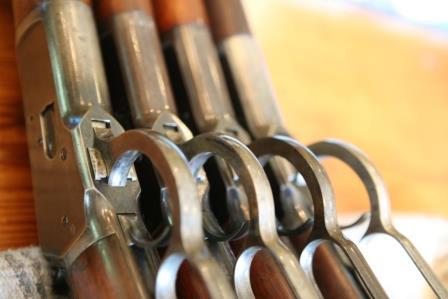November 17, 2011
 Offline
OfflineWould anyone here accept this rifle as original with a smoothbore but the barrel Not saying “smoothbore”? The .420 bore gives it some hope in my view.
September 19, 2014
 Offline
OfflineFolks,
I had been awaiting an answer by someone more expert on the model 1892 than I am. In absence of that, let me say that my smooth bore model 1873 does not say “smoothbore” anywhere on the rifle (or probably more appropriately, “gun”). I suspect the likely trick shooters did not need nor wish to have them readily identified as such, so their trick shots of breaking glass balls inside a tent seemed more likely to the audience to have been done with a single bullet vs. shot. My opinion only at this time. And yes, the factory letter supports it being a smooth bore 1873 in 44 WCF.
Tim
November 19, 2006
 Offline
OfflineI’m no expert on this either but it is intriguing. Tim, do you know the bore diameter of your .44-40? On the gun under discussion, one wonders if the bore simply measures .420 at the muzzle or is that the diameter throughout? Theoretically, there could be a constriction near the muzzle to act like a choke. For some reason the muzzle face troubles me. If I recall, many of the Winchester smoothbores would be marked under the barrel. This would likely be unknown to the original purchaser – as most Winchester purchasers are unaware of the various markings applied to the underside of the barrel.
March 20, 2009
 Offline
OfflineHello guys,
I first saw this rifle when it was auctioned by Julia in March of 2012 as lot 2049 and sold for $5175 as part of the Wes Adams collection. What I find most intriguing is the fact that the upper tang of the receiver is a Type 2 style which was last used during early 1909! 5 years before the serial number was applied. https://www.morphyauctions.com/jamesdjulia/item/lot-2049-extremely-rare-special-order-winchester-model-1892-smooth-bore-saddle-ring-carbine-44672/
The gun was later soffered out of RIA in September of 2015 as lot 21 but apparently did not sell. https://www.rockislandauction.com/detail/65/21/winchester-1892rifle
My feeling is that without “letterable” proof and the funky tang stamp it will always be a gun that has to have explanations for.
Michael

Model 1892 / Model 61 Collector, Research, Valuation
September 19, 2014
 Offline
Offlinesteve004 and others,
I drove a .429 bullet through the smooth bore 1873. After such the bullet measures .4234 in diameter. Without doing such for a sample of other rifled 1873’s, as I recall, the groove diameter varies from a rarely encountered .427 to nearly .430. If your lands are approx. .002 to .003 in depth/height, then it seems the smooth bored 1873 was simply pulled after the bore was first reamed and prior to the rifling (obvious) being cut. I have not nor intend to remove the magazine tube and fore end to determine if there is a notation of “smooth bore” under the fore end. Suffice to say it is noted in the letter, and in the listing by Gordon (at the time this rifle was noted as the earliest smooth bore, but since an earlier one was found). It is not noted on the visible portions of the barrel (which is 28 inches) There was no noticeable constriction at the muzzle for any effort to “choke” the rifle. It did not take long after seating the bullet in the bore that it could be pushed on through with some degree of effort.
Tim
November 17, 2011
 Offline
OfflineWinchester did the same thing with the .22 cal. smoothbores. They shipped out with a .219 smoothbore diameter which was just a normal barrel that did not have rifling grooves cut into it yet. If you try to hone out a rifled .22 to make a factory smoothbore the bore diameter will be at least about .225 so the fake barrel can be easily detected.


 Log In
Log In




